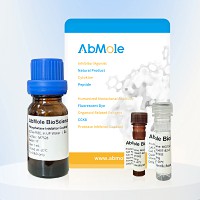All AbMole products are for research use only, cannot be used for human consumption.

In vitro: Tocilizumab inhibits the binding of IL-6 to its receptors, and thus reduces the cytokines pro-inflammatory activity by competing for both the soluble and membrane-bound forms of the human IL-6 receptor. The inhibitory profile of anti-IL-6R mAb Tocilizumab is independent of membrane-bound IL-6R expression. Tocilizumab has anticancer potency via apoptosis induction as an agonistic IL-6R regulator. It has also been demonstrated that tocilizumab has an anti-proliferative effect on glioma cells via inhibition of the JAK-STAT3 pathway. Tocilizumab exhibits a significant growth inhibition in NSCLC cells (H460, A549, H1299 and H358), with proliferation significantly decreased by approximately 40% in A549 cells. Tocilizumab does not alter the levels of the ERK1/2, STAT3, NFκB and phosphorylated ERK1/2 and STAT3 proteins, but this antibody does considerably increase the expression of phosphorylated NFκB in NSCLC cells. Tocilizumab significantly inhibits expression of both IL-8 and MMP-9, known as the major angiogenic factors.
In vivo: A series of clinical studies has shown that inhibition of IL-6 signaling by tocilizumab is therapeutically effective in rheumatoid arthritis, juvenile idiopathic arthritis, Castleman's disease, and Crohn's disease. In all of these diseases, tocilizumab ameliorates inflammatory manifestations, and normalizes acute phase protein levels. Tocilizumab as a monotherapy and in combination, such as with methotrexate in case of rheumatoid arthritis, seems to be well tolerated. Tocilizumab markedly decreases the number of invaded capillary vessels in tumors.
MW: 148 KD.

Research (Wash D C). 2022 Jul 19;2022:9826426.
Programming of Regulatory T Cells In Situ for Nerve Regeneration and Long-Term Patency of Vascular Grafts
Tocilizumab purchased from AbMole
| Cell Experiment | |
|---|---|
| Cell lines | non-small cell lung cancer (NSCLC) cells (A549, H460, H358 and H1299 cells) |
| Preparation method | Ten microliters of tocilizumab, MTX or 5-FU are added to 96-well plates containing 104 cells per well in 100 µl medium. The final concentrations of tocilizumab are 10, 100 and 1000 ng/ml. The final concentrations of MTX and 5-FU are 50 and 25 µg/ml, respectively. Following a 24-h incubation, WST-1 solution is added, and the optical density is analyzed at reference wavelengths of 450 and 620 nm. |
| Concentrations | 10, 100 and 1000 ng/ml |
| Incubation time | 24 h |
| Animal Experiment | |
|---|---|
| Animal models | Male CB17/ICR-scid/scid mice (SCID mice) |
| Formulation | PBS |
| Dosages | 100 μg |
| Administration | i.p. |
| Molecular Weight | 144984.63 |
| Formula | C6428H9976N1720O2018S42 |
| CAS Number | 375823-41-9 |
| Storage | -80°C for long term |
| Related IL Receptor/Related Products |
|---|
| IL-17A modulator-2
IL-17A modulator-2 is a IL-17A modulator. IL-17A modulator-2 inhibits the biological action of IL-17A with a pIC50 of 8.3. IL-17A modulator-2 can be used for the research of diseases associated with modulation of IL-17A activity. |
| IL-15-IN-1
IL-15-IN-1 is a potent and selective Interleukin 15 (IL-15) inhibitor, inhibiting the proliferation of IL-15-dependent cells with an IC50 of 0.8 μM. |
| IL-17 modulator 3
IL-17 modulator 3 is an IL-17 modulator. |
| IL-17 modulator 4
IL-17 modulator 4 is a proagent of IL-17 modulator 1. IL-17 modulator 1 is an orally active, highly efficacious IL-17 modulator. IL-17 modulator 4 is promising for the research of IL-17A mediated diseases, including inflammation, autoimmune diseases, infectious diseases, cancer, and precancerous syndrome. |
| IL-17A modulator-3
IL-17A modulator-3 is a IL-17A modulator. |
All AbMole products are for research use only, cannot be used for human consumption or veterinary use. We do not provide products or services to individuals. Please comply with the intended use and do not use AbMole products for any other purpose.


Products are for research use only. Not for human use. We do not sell to patients.
© Copyright 2010-2024 AbMole BioScience. All Rights Reserved.
